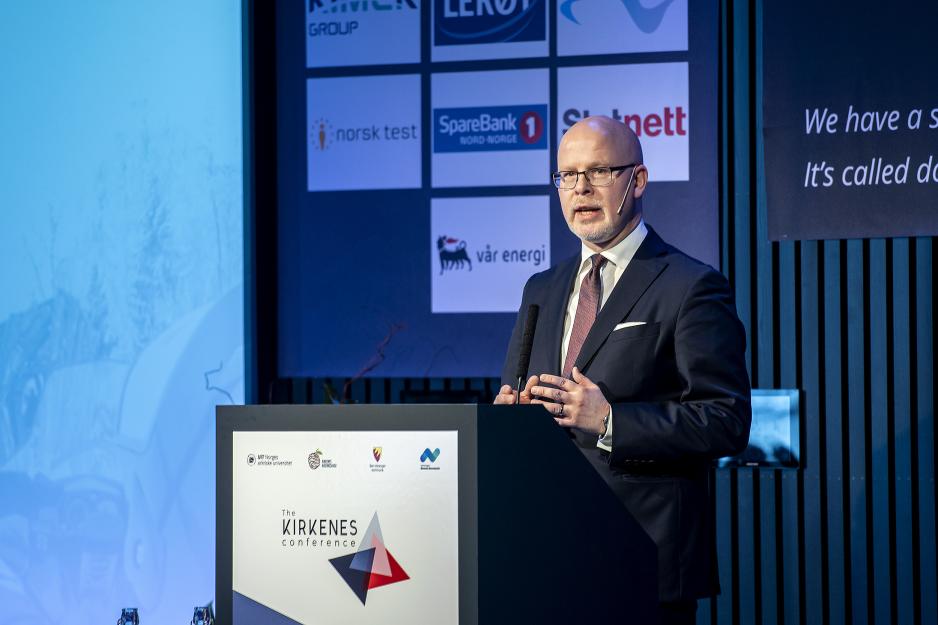Newsletter: The Elephant and the Glass House

State Secretary Audun Halvorsen of the Norwegian Ministry of Foreign Affairs gave a thorough review of the situation in the High North on the first day of the Kirkenes conference. Photo: Jonas Karlsbakk, the Barents Secretariat
Dear reader!
Last week, the annual threat assessment from the Norwegian Police Security Services (PST) was published. PST argues that Russian, Chinese and Iranian intelligence activities constitute the biggest threat against Norway and point to research institutions and innovation and technology companies as potential targets for foreign infiltration, both human and in the form of cyber attacks.
This week, it was the Foreign Intelligence Services’ turn to publish what they believe to be the biggest threats against Norway. “The factors affecting Norwegian threat perceptions the most come from Russia and China”, said Lieutenant-General Morten Haga Lunde when presenting the FIS’ threat assessment for 2020.
Very worried
The land-based mid-distance SSC-8 cruise missiles are a source of concern both for the Norwegian foreign intelligence and NATO. These missiles were the very reason the USA withdrew from the INF Agreement last year.
On Wednesday, NATO Secretary-General Jens Stoltenberg stated that he is “very worried about the new Russian missile systems”. He further stated that “The NATO alliance is working along several tracks to make sure it maintains its defense, both with new Russian missiles and without an INF agreement”. [Norwegian only]
This weekend, NATO’s maritime forces are visiting Bodø, Norway. That is not by chance, Commodore Yngve Skoglund, head of NATO’s standing maritime forces in Northern Europe, writes in an op-ed. [Norwegian only]
An old record with a notch
The many warnings about Russian weapon systems, both from Norway as well as NATO, loomed over most of the opening session of this year’s Kirkenes Conference, which takes place at a hotel located just a ten-minute drive from the Russian border.
Our Editor-in-Chief Arne O. Holm says that “the annual Kirkenes Conference’s continued insistence on good neighborly relations appears to be an LP record with a notch”. He further writes: “The reality is that the elephant has left the glass house. The glass house is a NATO riveted by internal fighting. Russia is the elephant that is no longer cooperating with the West.”
The Norwegian MFA maintains that the relationship between Norway and Russia is “clear, constructive and clarified”. However, MFA State Secretary Audun Halvorsen says there is no way Norway will enter into bilateral talks with Russia about Svalbard.
Another 100-year old
Last year, we marked the 100th anniversary of the signing of the Svalbard Treaty. This week, another 100-year old is at the center of the limelight. Russian author Fyodor Aleksandrovitch Abramov would have turned 100 years old on 29 February had he lived.
Abramov is a cultural icon in the Russian High North. His writings help us understand he history of the Russian North. His literary goal was to give a truthful description of life in a northern Russian village, and his story places current developments in Russia into perspective. Nevertheless, his texts also include a solid dose of criticism of Soviet politics. One of his essays could not be published until Stalin’s death, and even then it was condemned by the Russian writers’ union as well as by the central committee of the Communist Party. But readers love him.
Fewer “hot spots”
This month, ministers of environment and state secretaries from all the four countries of the Barents cooperation have met in Luleå, Sweden to discuss climate and environment cooperation in the Barents region. During the ministerial meeting, four environmental hotspots were taken off the Barents Council’s list of 42 prioritized sources of environmentally damaging emissions on the Russian side in the region, following documented improvements. [Norwegian only]
Soon applause for the Hero
In March, the Arctic conference High North Dialogue takes place in Bodø, Norway. “Dialogue is decisive for finding joint solutions and solving conflicts”, says Director of the High North Center Frode Mellemvik.
And once again, a High North Hero award is to be handed out. With award winners including a former prime minister and a leading scientist, the Award’s symbol represents an important contribution to development and creativity in the High North.
Last year’s award went to American environmental scientist Dr. Robert Corell.
Also read:
The US Coast Guard requests funding for another icebreaker
Danish historian welcomes post-Brexit Scotland back to Scandinavia
Spitsbergen or Svalbard? The answer includes both politics and history
We at High North News wish you all the very best for the weekend!
Siri Gulliksen Tømmerbakke
News Editor, High North News
